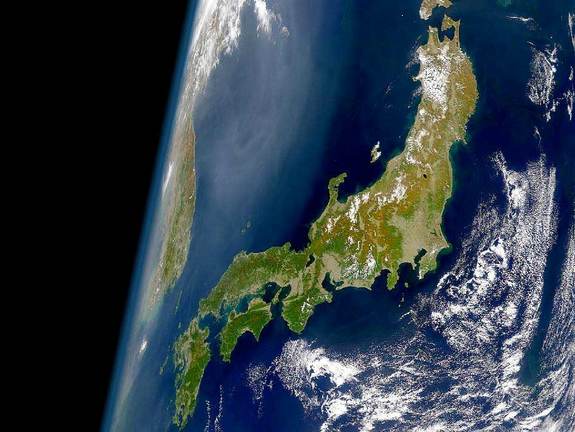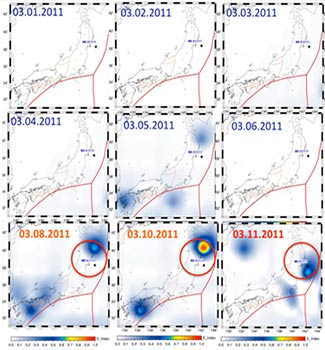Atmospheric changes prior to Japan quake revealed – could we predict quakes afterall?

Scientists say that the atmosphere above the epicenter of Japan’s catastrophic March 11 earthquake underwent significant changes prior to the tectonic thrust. Preliminary studies of the phenomena by Chapman University researcher Dimitar Ouzounov and several international colleagues could offer insight into how to predict powerful earthquakes well before they strike.
Using satellite data, they studied atmospheric conditions during the days leading up to the quake.
They found a large increase in the concentration of electrons above northeastern Japan, which peaked three days prior to the quake.
March 8 also saw a rapid increase in infrared radiation above the future epicenter. Both atmospheric changes disappeared following the main 9.0 magnitude quake. Similar phenomena have been detected prior to some other major earthquakes. (EarthWeek)
Infrared emissions from above the epicenter increased dramatically in the days before the devastating March 11 earthquake in Japan (Graphic: Dimitar Ouzounov)
The researchers have crunched data for more than 100 quakes in Asia and Taiwan, Ouzounov said, and have found similar correlations for earthquakes with magnitudes bigger than 5.5 and depths less than 31 miles (50 kilometers). The team is now working to involve researchers in Japan and worldwide, as ambitious atmosphere monitoring will take international effort, Ouzounov said.
Nonetheless, the success of earthquake forecasting is far from guaranteed. No one has ever predicted an earthquake from atmospheric data, and plenty of supposed earthquake precursors, from weird animal behavior to groundwater flowing the wrong way, have proven hit-or-miss.
"It's intriguing," said Henry Pollack, an emeritus professor of geophysics at the University of Michigan who was not involved in the research. "But it's hardly what I would call a breakthrough."
To iron out the usefulness of the atmospheric approach, Pollack told LiveScience, you'd need to look at lots of earthquakes over time to make sure the phenomena is statistically linked with fault ruptures. You'd also want to know how often these atmospheric anomalies show up without an associated quake.
Terry Tullis, an emeritus professor of geological sciences at Brown University, was similarly doubtful. Earthquake scientists have been "burned enough times in the past" and so have learned not to get excited about every potential prediction method, Tullis told LiveScience. But plans are underway to put together a workshop between earth scientists and atmospheric scientists this summer to discuss the research on the ionosphere changes, he said.
"I don't want to dismiss it out of hand," Tullis said. "But at this point, one has to be somewhat skeptical."
The full report is available at The Physics arXiv Blog. The researchers have also submitted their research report to a scientific journal. (LiveScience)
Ref: arxiv.org/abs/1105.2841: Atmosphere-Ionosphere Response to the M9 Tohoku Earthquake Revealed by Joined Satellite and Ground Observations. Preliminary Results.
Prof. Sergey Pulinets, researching earthquake precursors at the Institute of Applied Geophysics and the Moscow Center for Ionosphere Monitoring was interviewed by BueSo organizer Daniel Grasenack-Tente at the 2011 European Geosciences Conference this past week. Pulinets discusses the necessity of a multi-parameter approach to earthquake forecasting–from crust-related precursors, to the atmosphere, and the ionosphere.
Sergey Pulinets: A Multi-Parameter Approach to Earthquake Forecasting
The release of radon gases three days PRIOR to the May 11 Japan earthquake triggered changes in the atmosphere over Japan. It's early but this may be a warning signal to predict future quakes, says not-yet-published research by California scientists. The atmosphere above the epicenter of the March 11 earthquake in Japan underwent UNUSUAL CHANGES in the days leading up to the disaster, according to preliminary data.
The theory, which could move us forward in predicting quakes, is called "Lithosphere-Atmosphere-Ionosphere Coupling mechanism." Right before an earthquake, the stressed fault releases more gases, especially the colorless, odorless radon gas. Once in the upper-atmosphere ionosphere, the radon gas strips air molecules of their electrons, splitting them into negatively charged particles (the free electrons) and positively charged particles. These charged particles, called ions, attract condensed water in a process that releases heat. And scientists can detect this heat in the form of infrared radiation.
Using satellite data, researchers looked at what the atmosphere was doing in the days before the Japanese quake. They found that the concentration of electrons in the ionosphere increased in the days before the earthquake, as did infrared radiation. March 8, three days before the quake, was the most anomalous day. The researchers have crunched data for more than 100 quakes in Asia and Taiwan, and have found similar correlations for earthquakes with magnitudes bigger than 5.5 and depths less than 31 miles (50 kilometers). The team is now working to involve researchers in Japan and worldwide, as ambitious atmosphere monitoring will take international effort. Nonetheless, the success of earthquake forecasting is far from guaranteed. No one has ever predicted an earthquake from atmospheric data, and plenty of supposed earthquake precursors, from weird animal behavior to groundwater flowing the wrong way, have proven hit-or-miss.
To iron out the usefulness of the atmospheric approach, you'd need to look at lots of earthquakes over time to make sure the phenomena is statistically linked with fault ruptures. You'd also want to know how often these atmospheric anomalies show up without an associated quake. Earthquake scientists have been "burned enough times in the past" and so have learned not to get excited about every potential prediction method. But plans are underway to put together a workshop between earth scientists and atmospheric scientists this summer to discuss the research on the ionosphere changes. " (GlobalDisasterWatch)
Sergey Pulinets: A Multi-Parameter Approach to Earthquake Forecasting


Rajesh commented on The Watchers:
The studies on earth precursor development need a complete set of variables (precursory variables) from the world wide data. As the form of the energy release from a specific earthquake event behave like a function of local geology ( energy absorption and release is a characteristic property of material). So a precursor (i.e., change observed in a specific atmospheric parameter ) observed at one location may not be valid at other location. Even though, if we analyze the complete set of precursory variables it is possible to predict future earthquakes. (the energy release forms are still hidden i.e., not known completely). radiation’s emanating from the epicenter region always shows their characteristic spectral intensities which reacts with the atmospheric species and causes the un natural trends. .